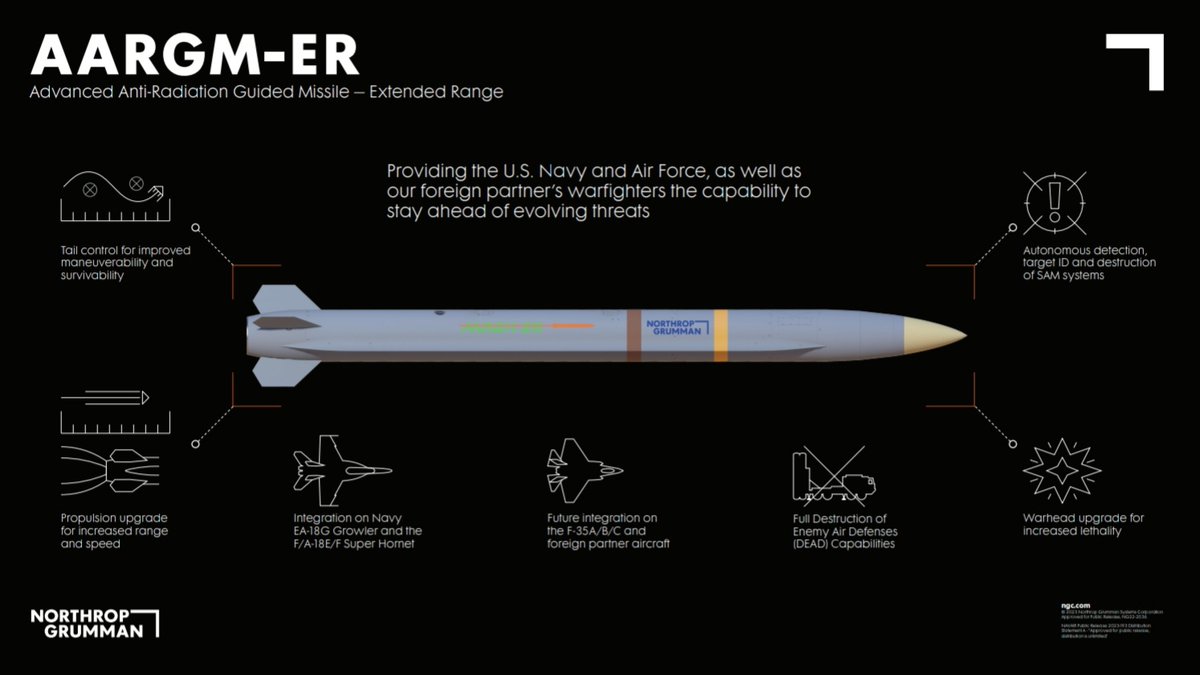Russia’s significant advances in missile production and the growing effectiveness of Moscow’s missiles in the ongoing war in Ukraine seem to have hastened the demands for anti-missile weapons in Europe and the United States.
Anti-missile systems also prioritize dealing with the increasing use of UAVs by adversaries. The older air defense systems are less capable of tracking UAVs due to their compact size, low radar cross-section (RCS), and reduced IR signatures. Therefore, countries are focusing on developing advanced air defense systems to counter the growing threat of UAVs.
It is against this background that on November 28, the US Department of Defense awarded a contract to Alliant Technsystems Operations, a wholly owned subsidiary of Northrop Grumman. It is worth US$235.7 million for the production of 118 AGM-88G Advanced Anti-Radiation Guided Missiles – Extended Range (AARGM-ER) for the US Navy alone.
The contract envisaged the delivery of 84 AGM-88G AARGM-ER All Up Rounds (AURs) for the US Navy (USN) and 34 AGM-88G AARGM-ER AURs for the US Air Force (USAF).
Alliant Techsystems is also to deliver six AGM-88G AARGM-ER captive air training missiles, eight telemetry/flight termination system kits for the USN, ten dummy air training missiles for the USAF, as well as initial spares, special tooling and test equipment kits, and associated supplies and support.
The AARGM mission is to suppress and destroy enemy air defenses (SEAD/DEAD). Its primary targets are re-locatable integrated air defense targets and targets that utilize shutdown tactics, which are neutralized through a multi-mode seeker.
An air-launched missile capable of rapidly engaging air-defense threats, the AARGM-ER configuration incorporates a new solid rocket motor for increased range. It is supposed to be integrated into the F/A-18E/F Super Hornet and EA-18G Growler aircraft, F-35A, Marine Corps F-35B, and Navy/Marine Corps F-35C.

The AARGM-ER began development in FY2016 and incorporates hardware and software modifications to improve the existing AGM-88E AARGM capabilities, including extended range, survivability, and effectiveness against future threats.
In May this year, Northrop Grumman Corporation announced the fifth consecutive successful flight test of the USN’s AARGM-ER). The missile was said to have successfully detected, identified, located, and engaged an advanced, land-based emitter target.
AARGM-ER development uses digital modeling and integrated advanced AARGM sensors and electronics in a new high-performance air vehicle with upgraded propulsion and an optimized warhead. The new missile is claimed to provide the US Navy, Air Force, and Marine Corps with a vital counter-air-defense capability that can engage advanced and long-range threats. At the same time, pilots remain outside of lethal engagement ranges.
Northrop Grumman, a leading global aerospace and defense technology company, has received orders from other countries for this new defensive missile and has obtained the necessary clearance for the US government to export.
Australia has decided to buy the AARGM-ER weapon for the Royal Australian Air Force (RAAF). The AARGM-ER will equip three RAAF combat types: the Boeing F/A-18F Super Hornet, EA-18G Growler, and Lockheed Martin F-35A, according to the Australian Department of Defense. Sixty examples are to be obtained for A$431 million (US$276 million), it is said.
Similarly, new NATO member Finland has decided to acquire up to 150 AARGM-ER in a foreign military sale approved by the US State Department.
“This proposed sale will support the foreign policy and national security of the United States by improving the security of a NATO ally that is an important force for political stability and economic progress in Europe,” according to a statement from the Defense Security Cooperation Agency (DSCA).
Incidentally, a recent business report suggests that the global missiles and missile defense systems (MMDS) market is valued at US$45.2bn in 2023 and will grow at a compound annual growth rate (CAGR) of 4.2% to reach a value of US$67.9bn by 2033. The cumulative market for global MMDS is anticipated to be valued at US$657.4 billion over the forecast period.
Demand for MMDS is anticipated to be driven by air defense modernization and advanced precision strike missile procurement programs by key defense spending countries, such as the US, Russia, China, India, Poland, and the UK, among others, the study states.
The missiles segment is expected to account for the largest share of 58.3% of the two primary segments in the global MMDS market from 2023 to 2033.
The key categories in the missile and missile defense systems market are missiles and missile defense systems. The missiles segment is further categorized into strategic land-attack, anti-ship, anti-radiation, conventional land-attack, anti-air, and anti-tank guided missiles (ATGM). Likewise, Platform-based MDS and missile-based CIWS are the two significant categories of missile defense systems.
In 2023, the MMDS market is expected to be led by the missiles segment and will continue doing so during the forecast period. It is said that the missile segment will be driven by multiple high-value procurement programs worldwide and the rise in the development & induction of low radar cross-section (RCS) missiles capable of operating at hypersonic speeds across militaries worldwide.
Analyzing the missile and missile defense systems market across several regions such as Europe, Asia-Pacific, North America, Middle East, Africa, and Latin America, the report says that “the MMDS market over the forecast period is expected to be led by Europe. The Russia-Ukraine conflict has increased demand for missile defense systems in the region, as several NATO countries are now focusing on improving their missile defense capabilities in the wake of the growing missile capabilities of Russia.
“This factor is expected to drive the MMDS market in the coming years. Ongoing partnerships among allied countries in Europe for the joint production and development of missiles is a key trend that will assist in cutting down on procurement costs through technology sharing.”
Incidentally, major players in the MMDS market are RTX Corp (RTX), Lockheed Martin Corp, MBDA Holdings SAS, Almaz-Antey Concern, Northrop Grumman Corp, and India’s Hyderabad-based Bharat Dynamics Ltd (BDL).
BDL produces anti-tank guided missiles, surface-to-air missiles, air-to-air missiles, and missile launchers. It is the prime production agency for the Indian Integrated Guided Missile Development Programme and includes several nuclear-capable missile systems, such as the Prithvi and Agni series.
Source : The Eurasian Times
















